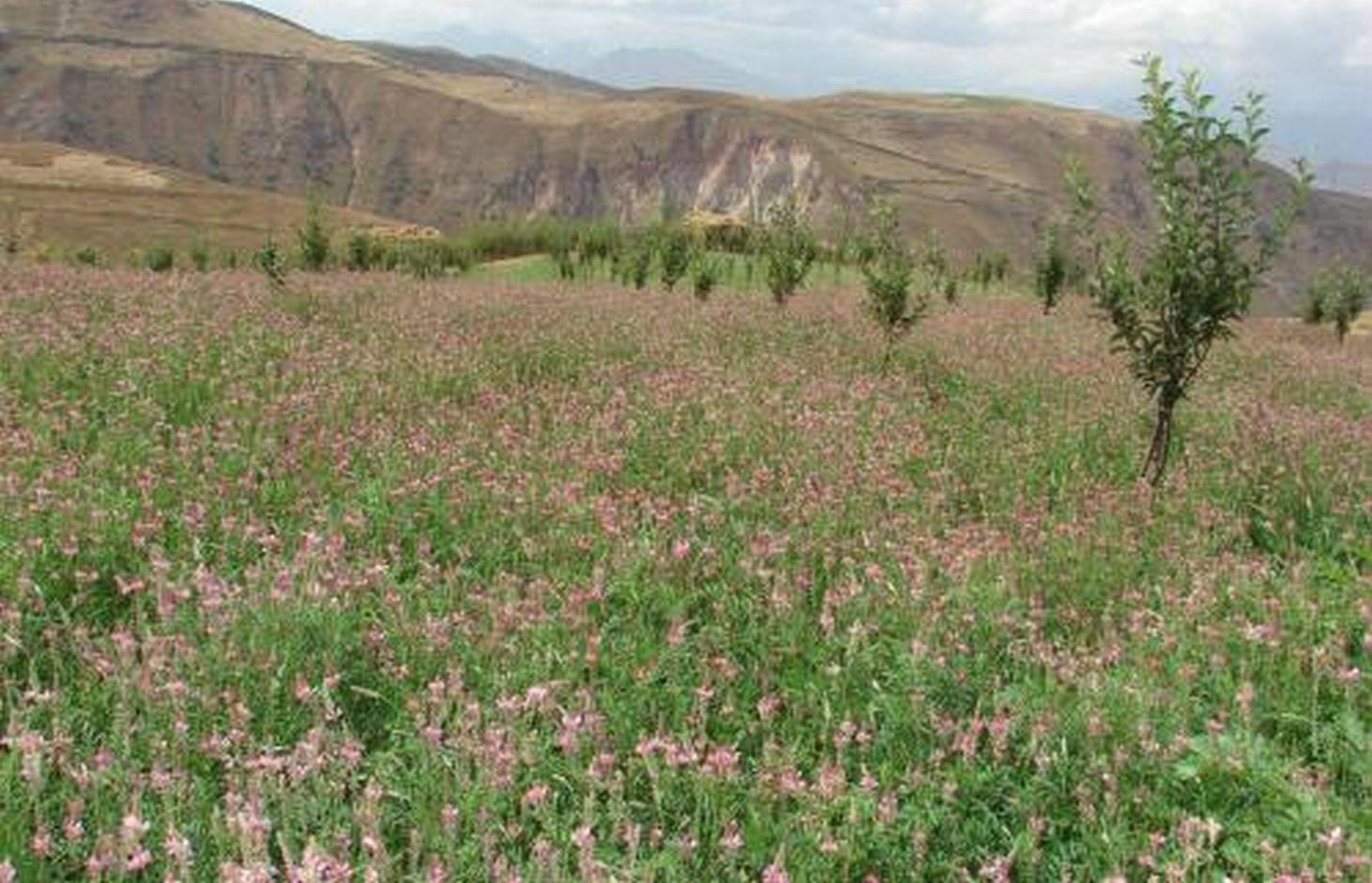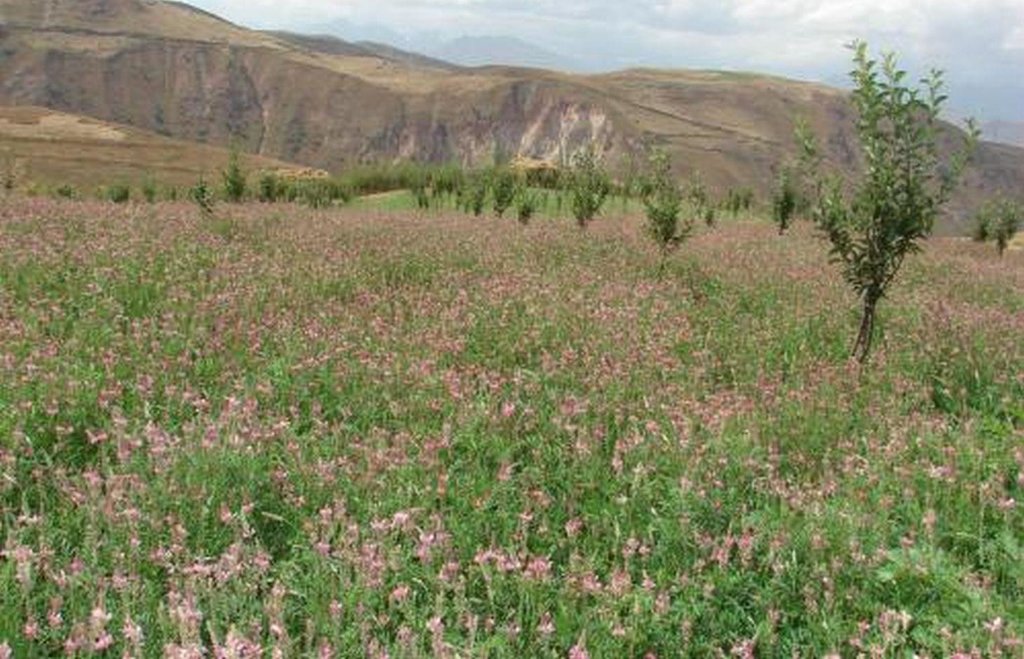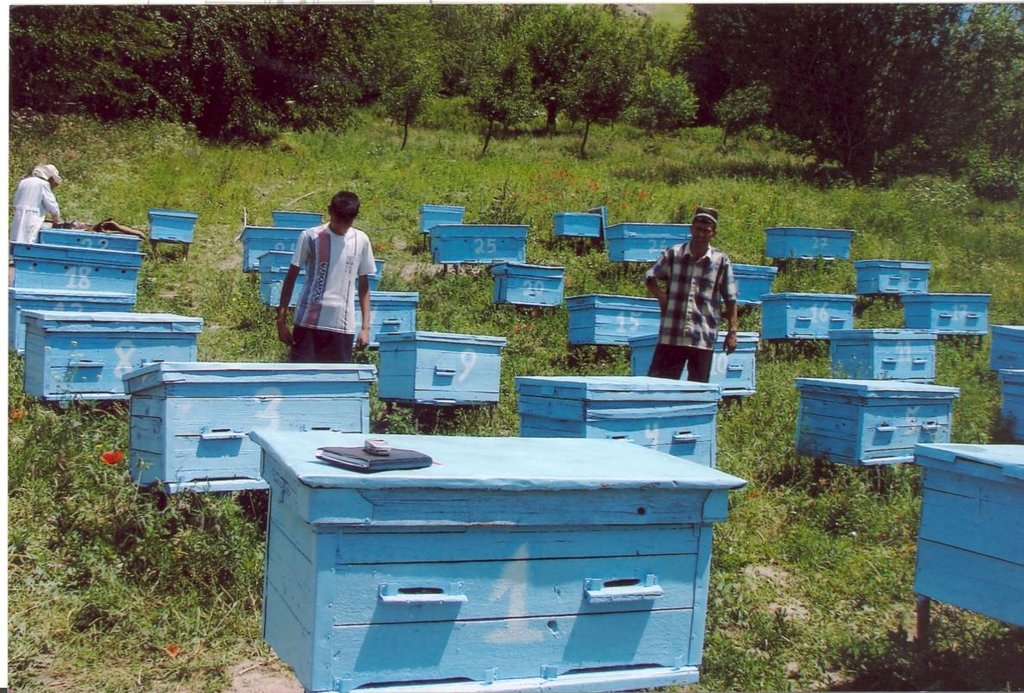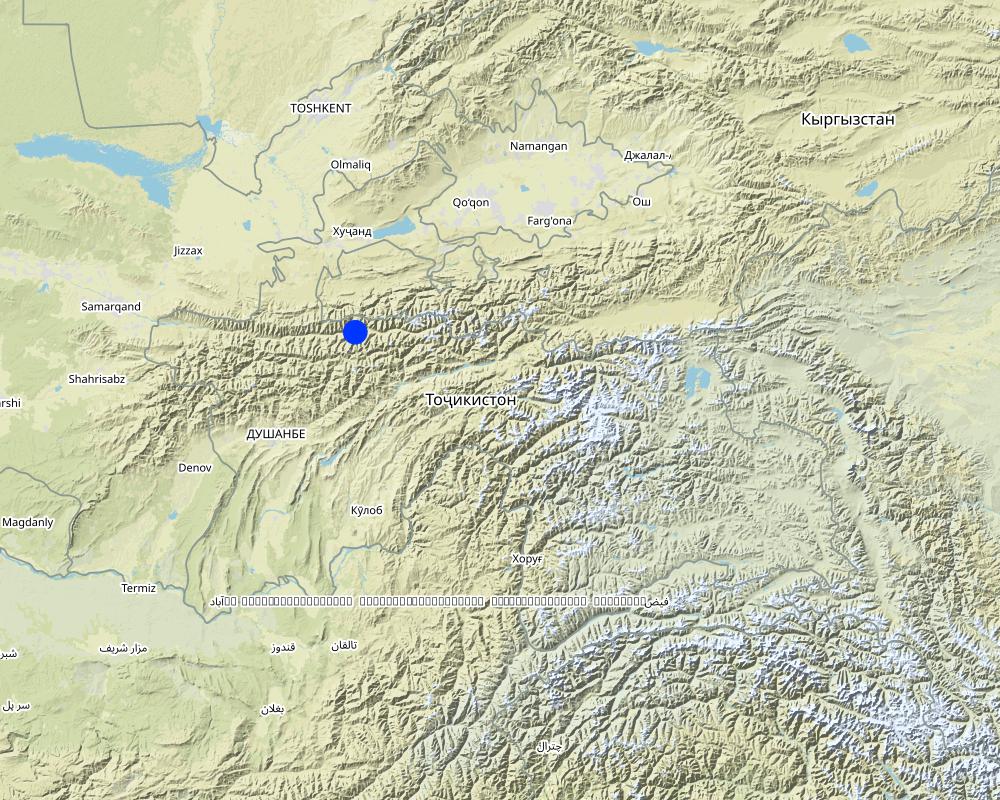Bee-keeping in uplands [Tajikistan]
- Creation:
- Update:
- Compiler: German Kust
- Editor: –
- Reviewers: Alexandra Gavilano, David Streiff, Joana Eichenberger
Beekeeping in uplands (English)
technologies_1040 - Tajikistan
View sections
Expand all Collapse all1. General information
1.2 Contact details of resource persons and institutions involved in the assessment and documentation of the Technology
SLM specialist:
Rustam Rakhimov
Community Agriculture and Watershed Management project in Tajikistan
Tajikistan
Name of project which facilitated the documentation/ evaluation of the Technology (if relevant)
Community Agriculture and Watershed Management project in Tajikistan (WB / CAWMP)Name of project which facilitated the documentation/ evaluation of the Technology (if relevant)
Pilot Program for Climate Resilience, Tajikistan (WB / PPCR)1.3 Conditions regarding the use of data documented through WOCAT
The compiler and key resource person(s) accept the conditions regarding the use of data documented through WOCAT:
Yes
2. Description of the SLM Technology
2.1 Short description of the Technology
Definition of the Technology:
Contributing to biodiversity conservation and land rehabilitation in uplands through beekeeping.
2.2 Detailed description of the Technology
Description:
In general technological goals are achieved indirectly in two main ways: (1) bees carry pollen over long distances as hives are carried from one place to another and help to spread these melliferous (honey producing) plants to uplands; (2) planting melliferous herbs (mainly esparcet and lucerne) on degraded pastures and arable lands as well as intercropping melliferous herbs in orchards. Melliferous herbs improve soil structure, accumulate organic carbon and increase crop capacity of high-energy fodder crops. These types of herbs also help to reduce pressure on nearby (winter) pastures.
Purpose of the Technology: Bee-keeping contributes to a diversified use of natural resources. Indirectly the project activities helps the preservation of biodiversity and rehabilitation of degraded lands. Through the combination of these impacts rural livelihoods can be improved.
Establishment / maintenance activities and inputs: Purchase of hives, bee-families and specific equipment (frames, separators, etc)
Natural / human environment: Any regions of Tajikistan are suitable. Technology requires specific knowledge, which can be obtained from local associations of bee-farmers which have been set up in all regions of the country. Through the CAWMP project local associations of bee-farmers have increased their knowledge and skills and strengthened their potential. Therefore the population got access to products of traditional medicine – honey and other useful products.
2.3 Photos of the Technology
2.5 Country/ region/ locations where the Technology has been applied and which are covered by this assessment
Country:
Tajikistan
Region/ State/ Province:
Tajikistan
Further specification of location:
Zarafshan, Surkhob, Vanj and Toirsu watersheds
Specify the spread of the Technology:
- evenly spread over an area
If precise area is not known, indicate approximate area covered:
- > 10,000 km2
Comments:
The technology has been applied under 159 subprojects (small grants) of the World Bank CAWMP project in 4 watersheds
Map
×2.6 Date of implementation
If precise year is not known, indicate approximate date:
- more than 50 years ago (traditional)
2.7 Introduction of the Technology
Specify how the Technology was introduced:
- as part of a traditional system (> 50 years)
Comments (type of project, etc.):
2006
3. Classification of the SLM Technology
3.1 Main purpose(s) of the Technology
- reduce, prevent, restore land degradation
- preserve/ improve biodiversity
3.2 Current land use type(s) where the Technology is applied
Land use mixed within the same land unit:
Yes
Specify mixed land use (crops/ grazing/ trees):
- Agro-silvopastoralism

Cropland
- Annual cropping
Annual cropping - Specify crops:
- vegetables - other
- lucerne, esparcet
Specify:
Водопотребление: богарное, смешанное богарно-орошаемое

Grazing land

Forest/ woodlands
Products and services:
- Other forest products
Comments:
Major land use problems (compiler’s opinion): poor vegetation cover, lack of access to water resources in some regions
Major land use problems (land users’ perception): soil erosion, poor vegetation cover, lack of irrigation water
Semi-nomadism / pastoralism: Yes
Improved pasture: Yes
Other grazingland: agro-silvo-pastoralism
3.4 Water supply
Water supply for the land on which the Technology is applied:
- mixed rainfed-irrigated
Comments:
Водопотребление: богарное, смешанное богарно-орошаемое
3.5 SLM group to which the Technology belongs
- beekeeping, aquaculture, poultry, rabbit farming, silkworm farming, etc.
3.6 SLM measures comprising the Technology

agronomic measures
- A1: Vegetation/ soil cover

vegetative measures
- V2: Grasses and perennial herbaceous plants

structural measures
- S11: Others

management measures
- M5: Control/ change of species composition
Comments:
Main measures: agronomic measures, vegetative measures, management measures
Secondary measures: structural measures
Type of agronomic measures: better crop cover, mixed cropping / intercropping, legume inter-planting
3.7 Main types of land degradation addressed by the Technology

soil erosion by water
- Wt: loss of topsoil/ surface erosion

biological degradation
- Bc: reduction of vegetation cover
- Bh: loss of habitats
- Bs: quality and species composition/ diversity decline
Comments:
Main type of degradation addressed: Bc: reduction of vegetation cover, Bh: loss of habitats, Bs: quality and species composition /diversity decline
Secondary types of degradation addressed: Wt: loss of topsoil / surface erosion
Main causes of degradation: overgrazing
Secondary causes of degradation: soil management, crop management (annual, perennial, tree/shrub), deforestation / removal of natural vegetation (incl. forest fires), disturbance of water cycle (infiltration / runoff), droughts, poverty / wealth, education, access to knowledge and support services, war and conflicts
3.8 Prevention, reduction, or restoration of land degradation
Specify the goal of the Technology with regard to land degradation:
- prevent land degradation
Comments:
Secondary goals: mitigation / reduction of land degradation, rehabilitation / reclamation of denuded land
4. Technical specifications, implementation activities, inputs, and costs
4.1 Technical drawing of the Technology
Technical specifications (related to technical drawing):
Technical knowledge required for field staff / advisors: moderate
Technical knowledge required for land users: moderate
Main technical functions: promotion of vegetation species and varieties (quality, eg palatable fodder)
Secondary technical functions: improvement of topsoil structure (compaction), stabilisation of soil (eg by tree roots against land slides), increase in organic matter, increase of infiltration, increase of biomass (quantity), spatial arrangement and diversification of land use
Change of land use practices / intensity level: additional use of melliferous (honey producing) plants
Control / change of species composition: control over melliferous plants in natural environment (meadows) and areas sown with legumes
4.2 General information regarding the calculation of inputs and costs
Specify currency used for cost calculations:
- USD
other/ national currency (specify):
сомони
Indicate average wage cost of hired labour per day:
5.00
4.3 Establishment activities
| Activity | Timing (season) | |
|---|---|---|
| 1. | Purchase of bee-hives and bee-families | |
| 2. | Preparing apiaries and hives | |
| 3. | Replacement of apiaries | |
| 4. | Purchase of specific beekeeping equipment | |
| 5. | Trainings on beekeeping | |
| 6. | Organization of purchases of materials, equipment and instruments | |
| 7. | Organization of seasonal transportation of apiaries | |
| 8. | Honey harvesting | |
| 9. | Sale of products and distribution of income |
4.4 Costs and inputs needed for establishment
| Specify input | Unit | Quantity | Costs per Unit | Total costs per input | % of costs borne by land users | |
|---|---|---|---|---|---|---|
| Labour | Labour | Persons/day | 1.0 | 5.0 | 5.0 | 100.0 |
| Equipment | Purchase of bee-hives and bee-families | hives | 10.0 | 5.0 | 50.0 | |
| Equipment | Purchase of specific beekeeping equipment | kits | 10.0 | 1.0 | 10.0 | 100.0 |
| Total costs for establishment of the Technology | 65.0 | |||||
| Total costs for establishment of the Technology in USD | 65.0 | |||||
4.5 Maintenance/ recurrent activities
| Activity | Timing/ frequency | |
|---|---|---|
| 1. | Repair of hives | |
| 2. | Keeping bees | |
| 3. | Seasonal transportation of apiaries |
4.7 Most important factors affecting the costs
Describe the most determinate factors affecting the costs:
Length of vegetative season, harsh cold spells (dying of bees), pests and diseases, ways of transportation of apiary, number of places for localization of apiaries in vegetative period, distance and conditions of transportation, availability of markets and etc.
5. Natural and human environment
5.1 Climate
Annual rainfall
- < 250 mm
- 251-500 mm
- 501-750 mm
- 751-1,000 mm
- 1,001-1,500 mm
- 1,501-2,000 mm
- 2,001-3,000 mm
- 3,001-4,000 mm
- > 4,000 mm
Specifications/ comments on rainfall:
Also < 250 mm and 751-1,000 mm
Agro-climatic zone
- sub-humid
- semi-arid
- arid
Thermal climate class: subtropics
Thermal climate class: temperate
Thermal climate class: boreal
5.2 Topography
Slopes on average:
- flat (0-2%)
- gentle (3-5%)
- moderate (6-10%)
- rolling (11-15%)
- hilly (16-30%)
- steep (31-60%)
- very steep (>60%)
Landforms:
- plateau/plains
- ridges
- mountain slopes
- hill slopes
- footslopes
- valley floors
Altitudinal zone:
- 0-100 m a.s.l.
- 101-500 m a.s.l.
- 501-1,000 m a.s.l.
- 1,001-1,500 m a.s.l.
- 1,501-2,000 m a.s.l.
- 2,001-2,500 m a.s.l.
- 2,501-3,000 m a.s.l.
- 3,001-4,000 m a.s.l.
- > 4,000 m a.s.l.
Comments and further specifications on topography:
Altitudinal zone: Also 101-500 m a.s.l.
Landforms: Also ridges and plateau / plains
5.6 Characteristics of land users applying the Technology
Market orientation of production system:
- mixed (subsistence/ commercial)
Level of mechanization:
- mechanized/ motorized
6. Impacts and concluding statements
6.1 On-site impacts the Technology has shown
Socio-economic impacts
Production
fodder quality
product diversity
production area
Socio-cultural impacts
food security/ self-sufficiency
health situation
community institutions
SLM/ land degradation knowledge
situation of socially and economically disadvantaged groups
Livelihood and human well-beeing
Comments/ specify:
Local associations of bee-farmers have increased their knowledge and skills, associations of bee-farmers have strengthened their potential, population got access to products of traditional medicine – honey and other useful products.
Ecological impacts
Soil
soil moisture
soil cover
soil loss
nutrient cycling/ recharge
soil organic matter/ below ground C
Biodiversity: vegetation, animals
biomass/ above ground C
plant diversity
beneficial species
habitat diversity
Climate and disaster risk reduction
emission of carbon and greenhouse gases
6.3 Exposure and sensitivity of the Technology to gradual climate change and climate-related extremes/ disasters (as perceived by land users)
Gradual climate change
Gradual climate change
| Season | increase or decrease | How does the Technology cope with it? | |
|---|---|---|---|
| annual temperature | increase | well |
Climate-related extremes (disasters)
Meteorological disasters
| How does the Technology cope with it? | |
|---|---|
| local rainstorm | not well |
| local windstorm | not well |
Climatological disasters
| How does the Technology cope with it? | |
|---|---|
| drought | not well |
Hydrological disasters
| How does the Technology cope with it? | |
|---|---|
| general (river) flood | not well |
Other climate-related consequences
Other climate-related consequences
| How does the Technology cope with it? | |
|---|---|
| reduced growing period | not well |
6.4 Cost-benefit analysis
How do the benefits compare with the establishment costs (from land users’ perspective)?
Short-term returns:
positive
Long-term returns:
very positive
How do the benefits compare with the maintenance/ recurrent costs (from land users' perspective)?
Short-term returns:
very positive
Long-term returns:
very positive
Comments:
With high market prices for this products it is a very beneficial investment
6.5 Adoption of the Technology
If available, quantify (no. of households and/ or area covered):
2584 households in an area of >10'000 km^2
Of all those who have adopted the Technology, how many did so spontaneously, i.e. without receiving any material incentives/ payments?
- 0-10%
Comments:
100% of land user families have adopted the Technology with external material support
Comments on acceptance with external material support: Data are taken from the results of CAWMP project, even though it is known that this technology is more widely used. According to experts, 20-25 times more across Tajikistan.
Comments on spontaneous adoption: Information is not clear, but the technology is very popular in Tajikistan
6.7 Strengths/ advantages/ opportunities of the Technology
| Strengths/ advantages/ opportunities in the land user’s view |
|---|
| improving public health |
| more money available |
| Strengths/ advantages/ opportunities in the compiler’s or other key resource person’s view |
|---|
|
Preservation and expansion of biodiversity in uplands How can they be sustained / enhanced? regular monitoring |
|
additional fodder crops How can they be sustained / enhanced? expand lucerne and esparcet plantations |
| improving health of rural population |
| improving rural livelihoods |
6.8 Weaknesses/ disadvantages/ risks of the Technology and ways of overcoming them
| Weaknesses/ disadvantages/ risks in the land user’s view | How can they be overcome? |
|---|---|
| high prices for specific equipment required for bee-farming | expand market of materials for bee-farming, stimulate domestic and small production of materials and tools |
| remoteness of melliferous areas |
| Weaknesses/ disadvantages/ risks in the compiler’s or other key resource person’s view | How can they be overcome? |
|---|---|
| Poor organizational structure used for transportation of beehives | develop associations of bee-farmers |
| lack of inventory of melliferous areas at national / regional level | governmental support to associations of bee-farmers in terms of inventory of melliferous areas |
7. References and links
7.1 Methods/ sources of information
7.2 References to available publications
Title, author, year, ISBN:
Data Base of the Community agriculture and Watershed Management Project (Narzimurod Kholov, Rustam Rakhimov)
Available from where? Costs?
Dushanbe, Rudaki 44, CAWMP PMU, free
Links and modules
Expand all Collapse allLinks
No links
Modules
No modules






